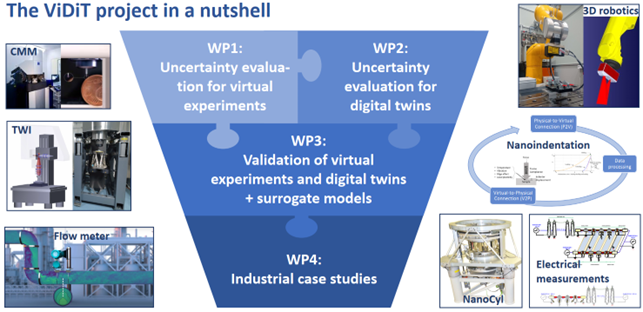New research project on virtual experiments and digital twins
News
New research project on virtual experiments and digital twins
In May 2023, the new research project “Trustworthy virtual experiments and digital twins” (ViDiT) started. ViDiT is a metrology project funded by the European Union. Metrology is the scientific study of measurement focusing on measurement reliability and is therefore the base for science, quality inspection, trade and many other needs of modern industrial society. The consortium of this three-year project consists of 21 institutions: eight National Metrology Institutes, two research centres close to industry, five universities and six companies. The project is coordinated by Physikalisch-Technische Bundesanstalt (PTB).
Virtual experiments and digital twins are key enabling technologies to achieve and realise European strategic policies devoted to sustainability and digitalisation within the complex framework of Industry 4.0 and the European Green Deal. Virtual experiments and digital twins are both simulation models that accurately replicate physical systems and characteristics in a virtual environment. Digital twins further include dynamic updates of the virtual model according to the observed state of its real counterpart. Hence, they consist of two parts, a Physical to Virtual connection that models the considered system and a Virtual to Physical connection that implements prevention and control strategies to achieve the target accuracy in the physical system.
The use of virtual experiments and digital twins in metrological applications requires uncertainty evaluation methods, as well as reliable validation procedures, to make them fit, e.g. as substitutes or extensions, to certified measurement devices. The ViDiT project will develop these methods and procedures to ensure the reliability and trustworthiness of virtual experiments and digital twins in metrology. The four technical work packages and selected applications of the project (coordinate measuring machine, tilted wave interferometer, flow measurement, 3D robotic measurement, nanoindentation, NanoCyl, and electrical measurement) are shown in Figure 1.

In addition, this will enable the traceability of modern measurement systems and it will boost and strengthen the European lead in this field. To facilitate the uptake of the developed methods, by National Metrology Institutes and industrial stakeholders, three good practice guides will be written, and the applicability of the methods will be demonstrated in twelve case studies covering the aforementioned industrial metrology applications.
The project has received funding from the European Partnership on Metrology, co-financed from the European Union’s Horizon Europe Research and Innovation Programme and by the Participating States.
More information on the research project can be found on its web page https://www.vidit.ptb.de